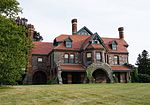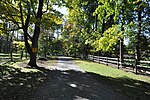Suffolk Resolves House

The Suffolk Resolves House is the building where the Suffolk Resolves were signed on September 4, 1774. The Resolves were an important predecessor document to the 1774 Continental Association and the 1776 Declaration of Independence. At that time, it was owned by Daniel Vose, who at his marriage had combined two existing buildings to make one house. The two parts are shown in the two gallery photographs. The oldest framing beams have been dated using dendrochronology which indicates that the trees used in the oldest portion of the house were felled in 1763.To prevent its demolition in 1950, Dr. James Bourne Ayer and Hannah Ayer moved it from its original location on Adams Street (where Citizens Bank now is) to its present location. They had it restored by William Morris Hunt and later gave it to the Milton Historical Society, for which it serves as headquarters.It was added to the National Register of Historic Places on July 23, 1973.
Excerpt from the Wikipedia article Suffolk Resolves House (License: CC BY-SA 3.0, Authors, Images).Suffolk Resolves House
Canton Avenue,
Geographical coordinates (GPS) Address Nearby Places Show on map
Geographical coordinates (GPS)
| Latitude | Longitude |
|---|---|
| N 42.234166666667 ° | E -71.108611111111 ° |
Address
Canton Avenue 1370
01286
Massachusetts, United States
Open on Google Maps









